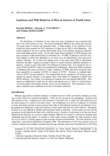Landraces and Wild Relatives of Rice as Sources of Useful Genes
JIRCAS international symposium series
| ISSN | 13406108 |
|---|---|
| NII recode ID (NCID) | AA1100908X |

Full text
intlsymp-2_104-111.pdf279.15 KB
The distribution of resistance to two major rice pests in landraces was compared with that in the wild relatives of rice. The brown planthopper (BPH) is one of the most harmful rice insect pests in tropical and temperate Asia. A large number of rice landraces of the world have been screened for BPH resistance in Japan and at IRRI in the Philippines. The results obtained in the two countries showed that most of the resistant landraces originated from South India and Sri Lanka. On the other hand, broad resistance to BPH biotypes was more common in wild relatives than in cultivated rice. At IRRI, 12 species of wild rice relatives resistant to BPH were identified, out of which, four are distributed in Asia and one in tropical Australia. All of these five species occur in the areas where BPH is distributed. However, the other 7 species occurring in Africa or tropical America exhibited allopatric resistance. Tungro is one of the major virus diseases in tropical Asia. It is caused by two viruses, RTBV and RTSV, which are transmitted by leafhoppers. More than 20,000 accessions of landraces have been screened for tungro resistance at IRRI, and some accessions have been reported to be resistant to RTSV or tolerant of RTBV. However, no resistant landraces to RTBV has been detected. Two hundred and eleven accessions in 20 species, representing the genetic diversity in the genus Oryza, were tested for resistance to RTBV and RTSV infection. Out of them, 15 accessions in 8 species were not infected with RTBV. Five species are distributed in Asia, but the other three species occur in Africa or Central America where tungro virus disease and the vectors are not distributed. The mechanism of sympatric resistance may be different from that of allopatric resistance.
| Creator | Ryoichi IKEDA Duncan A. VAUGHAN Nobuya KOBAYASHI |
|---|---|
| Publisher | Japan International Research Center for Agricultural Sciences |
| Available Online | |
| Issue | 2 |
| spage | 104 |
| epage | 111 |
| Language | eng |
